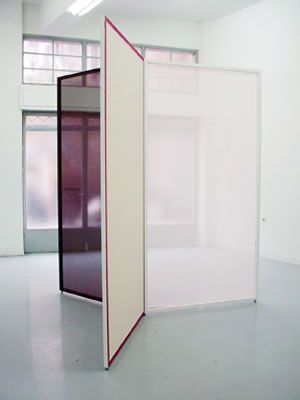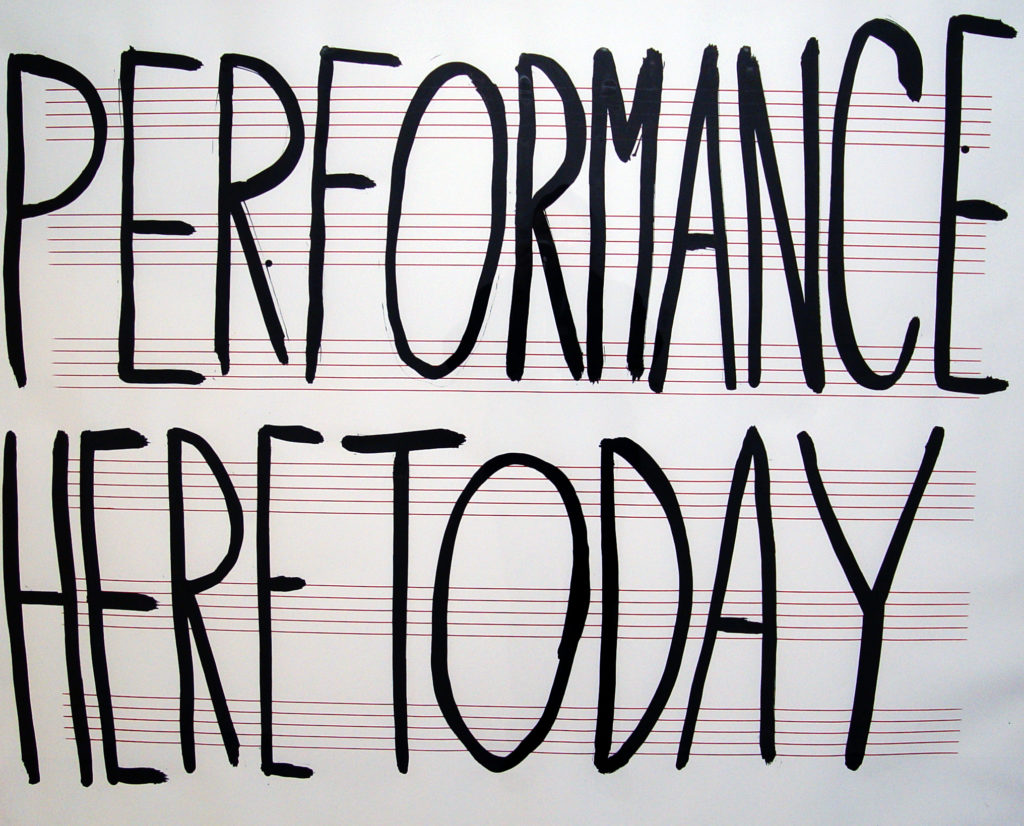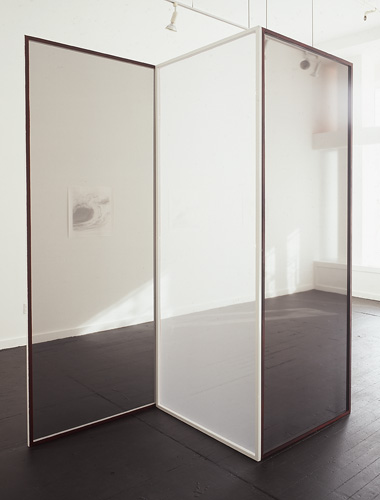Scott Myles
Solo exhibition
February 17, 2005–April 9, 2005The Breeder, Athens
Scott Myles
The Breeder, Athens
‘Revolver’, 2005 consists of a three-panel arrangement of georgette fabric stretched and secured to aluminium frames. These uniform rectangles are loosely based upon the revolving doors of a hotel situated opposite The Modern Institute in Glasgow – where Myles held his last solo exhibition. As a component of this exhibition in 2004 Myles created a transparent filter between his installation inside and the street outside by covering the windows of the gallery with chiffon, georgette and voile fabrics stretched over metal frames. The work, titled ‘After the Mountains, More Mountains’, 2004, accentuated a change in the city. Glasgow has been transformed from a city of heavy industry to one that hosts a service economy of call and conference centres and has seen its Victorian and Edwardian sandstone warehouses gradually torn down and replaced by particularly poor examples of late Post Modern design. Directly opposite the gallery is a particularly ugly example of such recent redevelopments – a four star Radisson SAS hotel built to accommodate conference delegates. The building, designed by gm+ad architects, is a long way from Arne Jacobsen’s Radisson SAS Royal Hotel (1960) in Copenhagen in both form and philosophy. ‘After The Mountains, More Mountains’ (later reassembled as a single, three dimensional, freestanding structure) and the building it once partially obscured were starting points for ‘Revolver’.
The surfaces of the work, depending upon how you approach them, can appear opaque or transparent. They recall the pavilions of Dan Graham in that they appear as props that establish their meaning when engaged with by their audience. As with the kinetic sculpture of László Moholy-Nagy, Myles’ work is as much concerned with the interplay of light on its fine fabric as with its form and the way in which people interact with it. As the title suggests, when pushed, the screens rotate like a revolving door but there is, of course, no inside or outside just an inescapable portal. Describing the work Myles quotes John Berger: “Men go backwards or forwards. There are two directions. But not two sides.”
’Revolver’, 2005, is accompanied by ‘The World in Nineteen Eighty Four’, 2005, a framed postcard, bearing an image of the Earth taken from space, purchased by Myles from a public observatory in Dundee, his hometown, in 1984. Myles appropriates the battered card (and the title of George Orwell’s famous novel of 1948). The image provides a pivotal image, in some ways a starting point for the exhibition. It is an object of personal significance and yet one that, at the same time, offers an expansive context for the other works in the exhibition.
A further freestanding sculpture, ‘The Public’, 2005 resembles ‘Revolver’ and ‘After The Mountains, More Mountains’ but is instead fashioned not from fabric but from sash window panels salvaged from a skip. Such traditional Victorian windows are often found lying in the street in Britain, having been stripped from houses and flats where they are replaced with new, cheap, plastic coated frames. Such refurbishment is a symptom of gentrification and indicative of social change within a community (normally as an area populated by rent paying tenants is transformed into one populated by owner occupiers). As with earlier works such as ‘Smoking in the Pavilion’, 2004 (an adapted bus shelter adorned with pairs of shoes tied together by their laces), Myles flattens this three-dimensional work by painting one side of the structure a bright colour, and the other dark as if to describe a fixed light source on the object and its resulting shadow.
‘We Are Building’ 2004, a pair of silk-screen prints on paper, appears almost as a product of ‘Revolver’ (which is literally an assemblage of ‘silk-screens’). In Myles’ deliberately crude, unregistered prints (where the screen has flooded, leaking onto the paper) an ordered pattern is formed from an image of rows of piano keys overlaid with further piano keys printed upside down. The resulting abstract image recalls a steel superstructure or a textile design. The work also bears some particular similarities to the musical notations of Modern composers such as John Cage and Steve Reich and brings to mind the compositions of Arnold Schönberg (who wrote music that could be played upside-down and back-to-front). There is also the suggestion of moving image as the rows of keys take on the appearance of successive film frames.
This fine balance between order and chaos in music is also explored in two further works. A painting depicts a combination of the logos of the seminal Los Angeles punk band Black Flag (designed by Raymond Pettibon in 1977) and the not dissimilar logo of the Massachusetts Institute of Technology Press (designed by Muriel Cooper in 1963). An untitled print is derived from a photograph taken by Myles of pairs of shoes, tied together by their laces and thrown over telephone wires. Such a public display as recorded by the artist is a coded indicator that illicit activity takes place in the immediate vicinity. Myles’s interest is in the way dysfunction can be organised or reorganised and in the way the shoes and the wires can appear to take on the appearance of a printed musical score.
A drawing, ‘Performance Here Today’, 2005, announces an event, hand written in Indian ink across oversized music tablature. The message in some ways seems to recall Bas Jan Ader’s famous installation ‘Please Don’t Leave Me’, 1969. Myles’ performance is as elusive as the reason for Ader’s pleading and yet, as handwritten messages, both works appear heartfelt and earnest. Ader is not specifically referenced by Myles (although in previous pieces he has appropriated the works of other artists working in a Conceptual tradition such as Victor Burgin and Felix Gonzalez Torres). What Myles shares with these artists is a generosity of spirit in that the work’s ambiguity invites the audience to find their own meaning or context. Like ‘Revolver’ the work leaves us in a permanent state of anticipation.
Scott Myles’ practice adopts and appropriates many ideas and forms from a variety of sources and traditions and yet the resulting works have a highly individual, visual vocabulary. Although resolutely contemporary they can be seen to explore more timeless ideas of cycles. However, within this enquiry it is thresholds that provide a recurring theme: unclaimed, ambiguous areas between inside and outside, between order and chaos, between the physical and the ephemeral, and between two and three dimensions.
Rob Tufnell 2005


